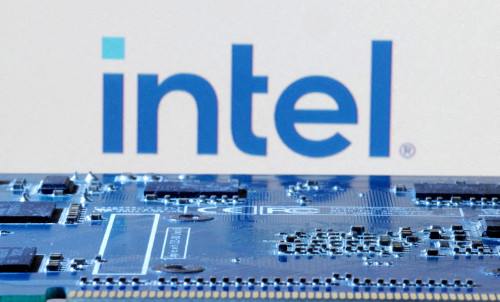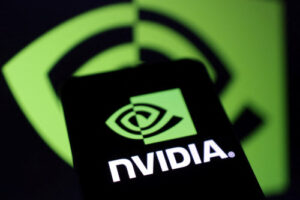By Max A. Cherney, Arsheeya Bajwa and Stephen Nellis
(Reuters) – Intel forecast second-quarter revenue below Wall Street estimates on Thursday, casting a shadow over new CEO Lip-Bu Tan’s first round of earnings at the helm, against the backdrop of a raging Sino-U.S. trade war.
Intel shares were down 5.8% in extended trading.

Ad RAD Intel
From Unknown to Unstoppable: The Pre-IPO AI Opportunity You Can Still Grab
You know that moment when a company goes from "never heard of" to "suddenly everywhere?" That's RAD Intel – and you can still invest. The company's valuation has already exploded 16X, from $5m to $85m and is growing despite market uncertainty.
Here's why insiders love them. They're helping Fortune 500 brands like Hasbro and MGM truly understand their audiences in real time - not just guess. It's AI that actually works. Pre-IPO, and fixing a multi-trillion dollar problem.
The company's proprietary AI-tech teaches brands how to create and deliver content that reads the room. RAD's tech helps brands understand why content works, who it actually resonates with, and what to say next. Now, brands can stop guessing and start making ads that actually land.
This company is on fire. Shares are just $0.60 – with backing from Adobe and Fidelity. Strength attracts strength: over 6,000 investors are in, including insiders from Google, Meta, and Amazon.
Get the full details before the next price change on 5/29.
DISCLOSURE: This is a paid advertisement for RAD Intel's Reg A offering. Please read the offering circular and related risks at invest.radintel.ai.
The dour outlook from Intel could be another source of pessimism for investors who are counting on Tan to turn the chipmaker around after years of missteps have left it struggling to gain a foothold in the booming AI market.
The Santa Clara, California-based company expects revenue of $11.2 billion to $12.4 billion for the June quarter, compared with analysts’ average estimate of $12.82 billion, according to data compiled by LSEG.
Fears around tariffs pushed customers to stockpile Intel chips, which boosted sales in the first quarter, CFO David Zinsner said. The company was not able to determine the amount of the benefit, and it expects the second quarter to suffer as a result.
“Our guidance this quarter, in the second quarter, is a reflection of this uncertainty caused by tariffs,” the finance chief said.
Amid Tan’s attempts to streamline the company and cut costs, Intel also said it is reducing its adjusted operating expense target to approximately $17 billion in 2025, down from its previously stated goal of $17.5 billion, and is now targeting $16 billion in 2026.
“There’s a lot of Intel bureaucracy that has been built up over time,” Zinsner told Reuters. “He wants to cut through all of that to make engineers more successful and allow them to more quickly bring out products. We’ve got to go through all of that.”
The finance chief said it was not yet certain what impact the restructuring plans would have on the overall employee count but that clarity would emerge when the company reports second-quarter results.
In a memo to employees ahead of his first conference call with analysts as CEO, Tan wrote that layoffs would begin in the second quarter and that such changes would focus on reducing the company’s internal bureaucracy. Tan also plans to slash the number and size of internal meetings.
“”There is no way around the fact that these critical changes will reduce the size of our workforce,” Tan wrote. “As I said when I joined, we need to make some very hard decisions to put our company on a solid footing for the future.”
Beginning on September 1, Intel will require employees to return to the office four days a week, Tan’s memo said.
The company also reduced its gross capital expenditures target to $18 billion for 2025, down from the company’s previous target of $20 billion.
“Intel is taking actions to drive better, more efficient execution across the business. The plan includes streamlining the organization, eliminating management layers,” the company said in a statement.
While U.S. President Donald Trump has for now spared chips from tariffs, Beijing’s high retaliatory levies on U.S.-made semiconductors cloud the outlook for Intel’s sales to China, typically its largest market.
Chips manufactured in the U.S. are set to face levies of 85% or higher, based on the state-backed China Semiconductor Industry Association’s notice earlier in April.
China imports $10 billion worth of chips from the United States annually. About $8 billion of these are central processing units (CPUs) assembled by Intel in the U.S., according to Bernstein analysts.
Intel’s first-quarter revenue was flat at $12.67 billion. The results beat estimates of $12.30 billion.
The company expects second-quarter per-share adjusted profit to break even, compared with estimates of profit of 6 cents per share.
“The cautious (second quarter) outlook incorporates tariff uncertainties coupled with the competitive environment in both the PC client and the datacenter markets,” Summit Insights analyst Kinngai Chan said.
Intel’s drive to become a contract manufacturer of chips, a strategy championed by Tan’s predecessor, Pat Gelsinger, has strained the company’s finances as it pours billions of dollars into setting up advanced manufacturing facilities.
(Reporting by Arsheeya Bajwa in Bengaluru and Max A. Cherney and Stephen Nellis in San Francisco; Additional reporting by Shanima A in Bengaluru; Editing by Peter Henderson and Matthew Lewis)





